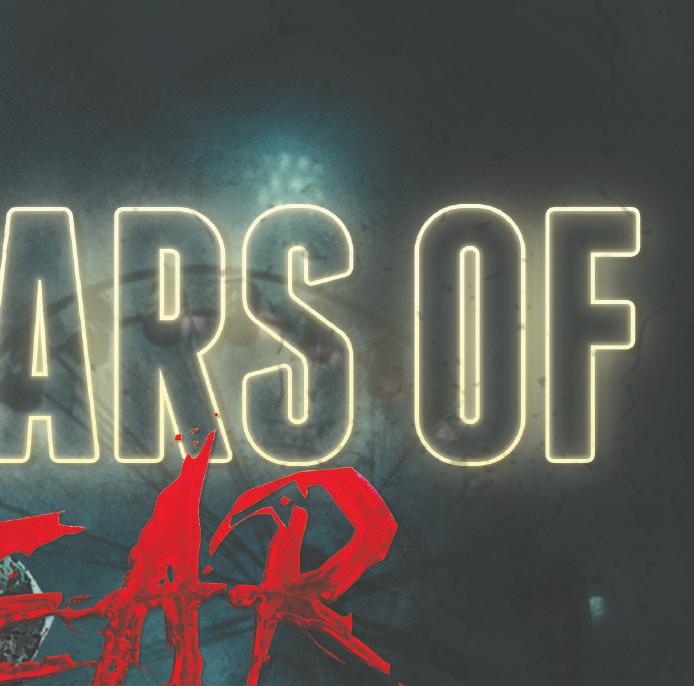





VOL. 104 ISSUE: 10
CONTACT THE DN Newsroom: 765-285-8245
Editor: 765-285-8249,
editor@bsudailynews.com
EDITORIAL BOARD
Kate Farr, Editor-in-chief
Trinity Rea, Print Managing
Editor
Olivia Ground, Digital Managing
Editor
Katherine Hill, News Editor
Meghan Braddy, Associate News
Editor
Zach Carter, Sports Editor
David Moore, Associate Sports
Editor
Derran Cobb, Associate Sports Editor
Ella Howell, Lifestyles Editor, Copy Editor
Maria Nevins, Video Editor, Podcast Editor
Layla Durocher, Social Media
Editor
Andrew Berger,Photo Editor
Isabella Kemper, Associate Photo Editor
Jessica Bergfors, Visual Editor
Brenden Rowan, Visual Editor
Corey Ohlenkamp, Adviser
The Ball State Daily News (USPS-144-360), the Ball State student newspaper, is published Thursdays during the academic year except for during semester and summer breaks. The Daily News is supported in part by an allocation from the General Fund of the university and is available free to students at various campus locations.
TO ADVERTISE
• (765) 285-8256 or dailynewsads@bsu.edu
• Hours: 8 a.m.-5 p.m. Mon-Fri.
• ballstatedaily.com/advertise
TO SUBSCRIBE
Call 765-285-8134 between 9 a.m. and 3 p.m. Mon. -Fri.
Subscription rates: $45 for one year. POSTMASTER: Send address changes to Daily News, AJ278, Ball State University, Muncie, IN 47306
JOIN THE DAILY NEWS
Stop by room 278 in the Art and Journalism Building. All undergraduate majors accepted and no prior experience is necessary.
The Ball State Daily News is committed to providing accurate news to the community. In the event we need to correct inaccurate information, you will find that printed here.
To submit a correction, email editor@bsudailynews.com.








Oct. 14: NASA launched the Europa Clipper spacecraft Oct. 14, embarking on a mission to explore Jupiter’s moon, Europa, according to the Associated Press (AP). The spacecraft will take over five years to reach Jupiter, where it will orbit the planet and perform dozens of close flybys of Europa. Although the mission won’t search for life directly, Europa Clipper will investigate whether the moon’s ocean, hidden beneath miles of ice, has the right conditions to support life. The $5.2 billion spacecraft, which faced technical and weather-related challenges, is now on its way to carry out the exploration, according to AP.








Oct. 14: A deadly drone strike by Hezbollah has intensified concerns about Israel’s air defenses. According to the Associated Press (AP), a drone evaded Israel’s systems Oct. 13 and hit a mess hall at a military training camp, killing four soldiers and wounding 67 others. This occurred despite Israel’s air-defense array, which is designed to intercept rockets and missiles. The strike, one of many recent drone attacks by Hezbollah, highlights growing vulnerabilities in Israel’s defenses. Israeli officials are investigating the breach and working on solutions to better counter the drone threat, according to AP.


































Oct. 17: Over the weekend, Ball State traveled to Mount Pleasant, Michigan, to face off against Mid-American Conference (MAC) opponent Central Michigan. The Cardinals improved to .500 in MAC play with the 3-1 win over the Chippewas. Next, the red and white went south to Ann Arbor, Michigan, taking on the No. 5 ranked Wolverines. Ball State fell in the contest 0-4, and with the loss, fell to 3-8 overall on the year. The Cardinals will stay on the road with another chance to improve their conference record as they travel to Boone, North Carolina, for a matchup against Appalachian State Oct. 18 at 6 p.m.


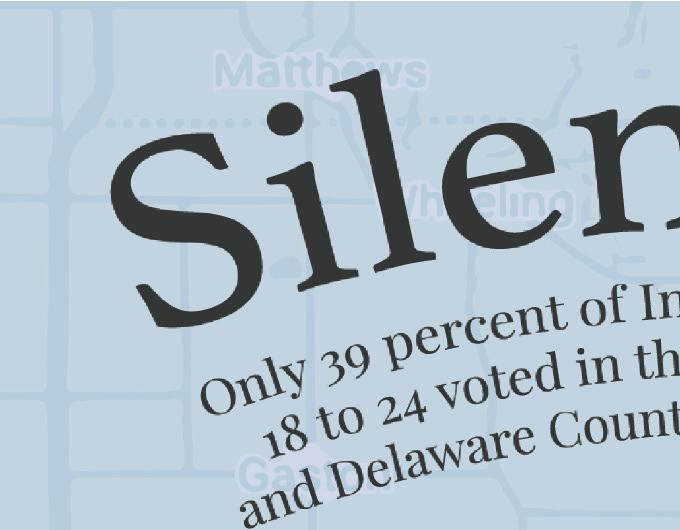

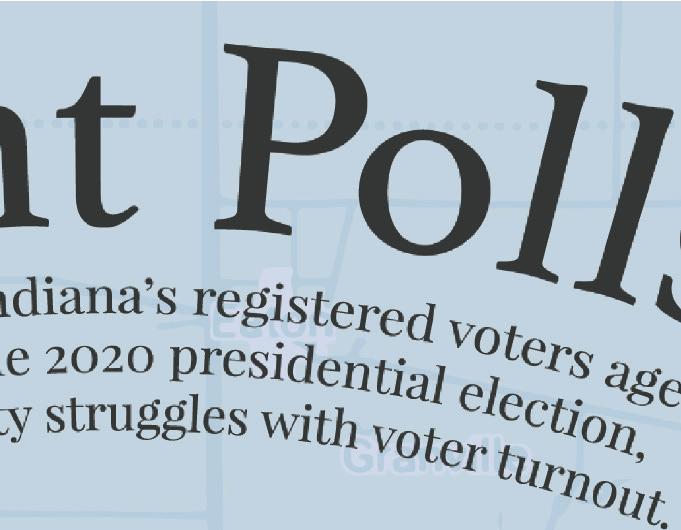


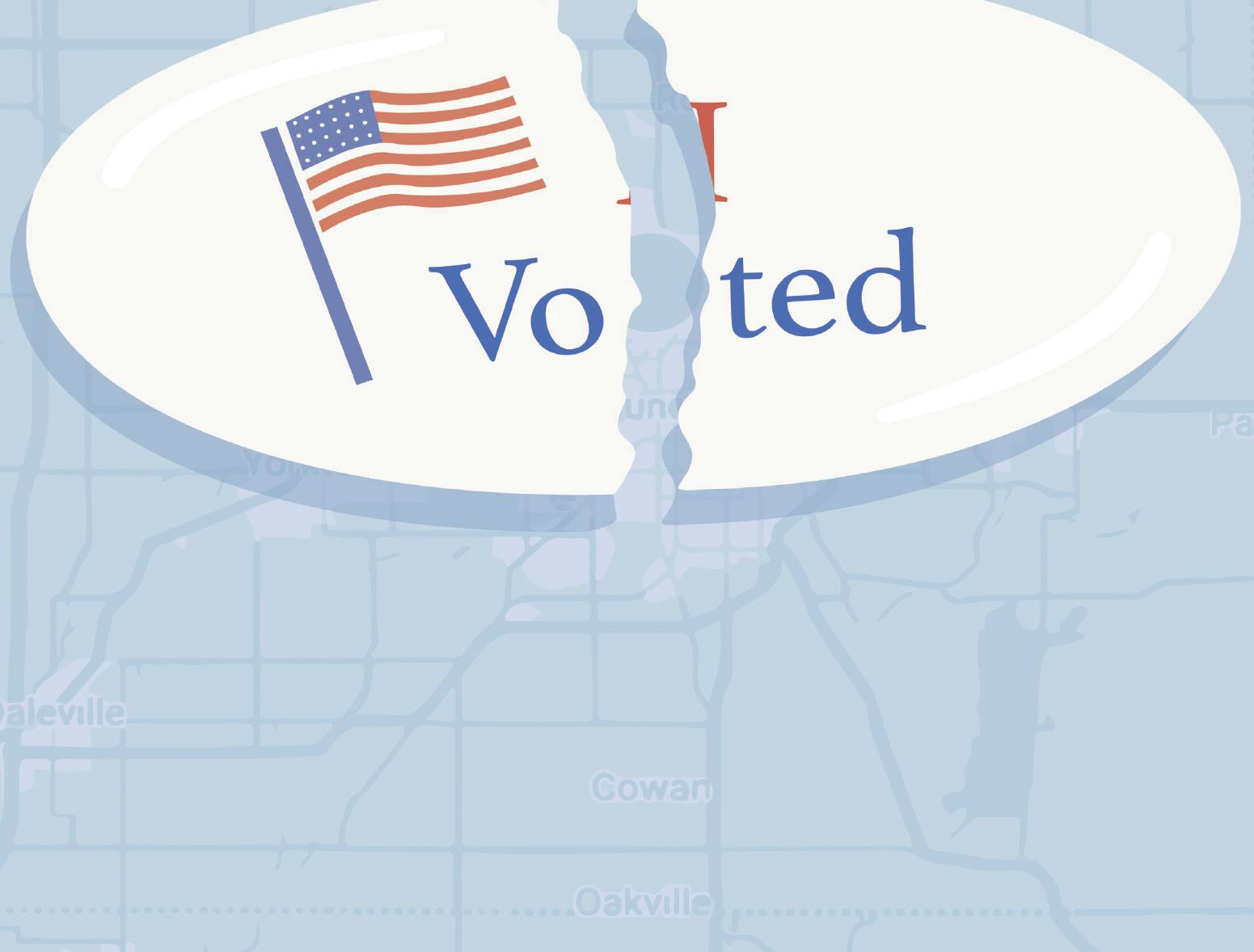
U.S. Senator Mike Braun is urging the Indiana Utility Regulatory Commission to reject AES, Indiana’s plan to convert its Petersburg Generating Station from coal to natural gas, according to the Indiana Capitol Chronicle. He warns closing coal plants too quickly could harm the energy grid and urges collaboration to preserve coal as a reliable energy source.
A judge accepted former Clark County Sheriff Jamey Noel’s guilty plea Oct. 14. Noel was charged with 31 felonies for allegedly misusing money from the fire and EMS departments he oversaw and pleaded guilty to 27 of those in August. He could spend upwards of a decade in prison, according to Indiana Capital Chronicle.
According to an official statement, Indiana Representative Sue Errington (D-Muncie) will host an environmental roundtable Oct. 22 at the Muncie Public Library, starting at 6 p.m. The roundtable will focus on creating systems to move beyond traditional recycling methods to embrace a circular economic approach and minimize waste.
The Ball State Daily News and NewsLink Indiana sat down with the candidates from the 2024 gubernatorial election.
EDITOR’S NOTE: The Ball State Daily News and NewsLink Indiana reached out to the Republican Party of Indiana and various contacts related to Mike Braun for Indiana and Mike Braun for Senate teams. After working for nearly two months to get in touch with Braun, he ultimately rejected the opportunity to interview with the Ball State Daily News and NewsLink Indiana. His team said he would be unavailable due to a “busy schedule.”
The upcoming gubernatorial race has been one of much anticipation for Hoosiers, largely due to the close nature of the election. Recent polls from Activote, a nonpartisan political education app, show the Republican Party only has an eight-point lead over the other candidates — a closer margin than the last election cycle in 2020.
The Ball State Daily News and NewsLink Indiana sat down with candidates from all three political parties represented in the race to answer questions on the topics facing students and community members.
Jennifer McCormick (D) believes that she is the true representative of the modern Hoosier. Previously holding the State Superintendent of Public of Instruction position as a Republican, the Yorktown local and Ball State alumna switched parties after seeing the direction the state was heading politically.
“So many people come up to me and say, ‘I’m you … I was a Republican, and I switched parties,’” McCormick said. “For me, it was about values. I am very fiscally conservative, but I also believed in empowering opportunities for people … I also believe in diversity and inclusion and that we are better when we are all together.” McCormick is running for governor with her running mate Terry Goodin (D).
Goodin, a previous representative for District 66, also served as superintendent of Crothersville Community Schools and the USDA’s Indiana state director for rural development, according to a press release from the Indiana Democrats.
“He will work with farmers; it’s not top down,” McCormick said about Goodin.
McCormick and Goodin summarized their campaign as one focusing on restoring political balance in the statehouse, reproductive rights,
affordable healthcare, the economy and education “across the board.”
Specifically concerning education, McCormick looks to create a plan of universal pre-K that includes the ages of 0-5 and creating affordable childcare, citing that “a third” of Indiana counties don’t have accessible and affordable childcare.
According to Early Learning Indiana, twothirds of Indiana counties lack the capacity to provide childcare.
When addressing K-12 education, specifically high school curriculums and graduation requirements, McCormick puts importance on “transferable skills,” like exposure to many ideas, class subjects and a “well-balanced curriculum.”
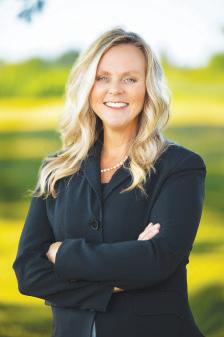
For me, it was about values. I am very fiscally conservative, but I also believed in empowering opportunities for people … I also believe in diversity and inclusion and that we are better when we are all together.”
-
JENNIFER
MCCORMICK (D), Governor candidate
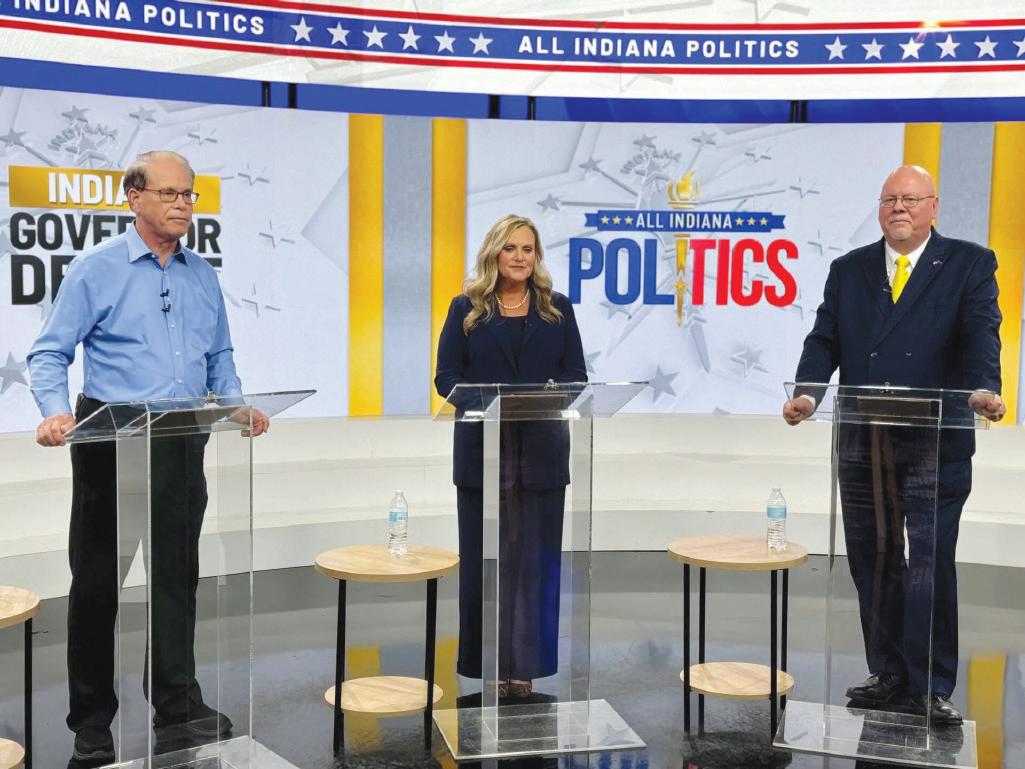
reinstating abortion access in the state, which was overturned after the passing of Senate Bill (SB) 1 and the overturning of Roe v. Wade.
“I am the only candidate who has been pregnant, has given birth and is a mom,” McCormick said, “I know firsthand the complexities of pregnancy … I trust women. I trust healthcare providers … The concern is it’s healthcare, and we need autonomy to make decisions.”
According to her website, McCormick’s campaign has intentions to “examine all potential paths to a constitutional amendment that restores access to abortion services,” “appoint Indiana Supreme Court justices who believe in upholding reproductive rights and freedoms,” protect IVF care and “work to provide state-wide access to maternal health services, addressing our state’s 25 counties deemed ‘maternity care deserts’ while understanding 30% of our counties are without an OB-GYN.”
McCormick has also boasted of her campaign’s “common sense cannabis legalization plan,” which would include a path to medical usage with an eventual path to legalization for adult recreational use. It would also include the creation of a cannabis commission, citing the employment and revenue increases it would bring to the state.
policies that protect our wetlands, water, air, soil, recreational forests and wildlife,” “join the bipartisan group of governors in the U.S. Climate Alliance,” and “uphold protections on the ownership and stewardship of our farmland against foreign adversaries.”
“I grew up taking care of your water and your air and your soil conservation … you do your cover crops … so making sure we are doing our due diligence,” McCormick said, referring to her experience growing up with a father who was a farmer. “That’s where our lieutenant governor comes in … But the first part of it is acknowledging [the climate crisis].”
Donald Rainwater (L), a navy veteran and lifelong Hoosier, is running in his second campaign as a candidate for governor. A computer applications instructor, manager of a residential property and manager of a retail store, Rainwater is running with Tonya Hudson (L), a real estate broker from Indianapolis.
“I was a teacher and local school superintendent and principal, but I’m also a mom,” McCormick said. “It’s nonsensical. I’m not sure why we would tell kids that bringing down the rigor and exposing them to less is a good thing,” McCormick said, regarding the proposed changes to Indiana high school diplomas that many parents had concerns about. McCormick and Goodin have intentions of
“It’s already in Indiana. A lot of people are going to Illinois or Ohio to get it … we want to look at states who did it well and states who struggled and get the best of the best and go into adult use eventually,” McCormick said.
One of the ways the McCormick and Goodin ticket plan to tackle agriculture is through environmental protections and sustainable energy.
According to the McCormick and Goodin campaign website, they plan to “create a Office of Environmental Justice,” “create an overall water management plan,” “promote
Most pre-election polls show the Libertarian Party having anywhere from 6 to 9 percent of projected votes, a decrease from the last election cycle, where they were projected to have 10 to 15 percent of the votes. Ultimately, the party had around 11 percent of votes on election day in 2020.
“The Libertarian Party is focused on individual rights and minimal government,” Rainwater said. “We believe that the Founding Fathers, when they wrote the Constitution, intended for us to be able to be self-governing, and part of the essential human rights is the ability for someone to determine their destiny without government constantly interfering in every piece of that.”
The largest campaign plan Rainwater and Hudson present are their policies on taxes and
taxing in Indiana.
“Local governments are being allowed to spend money on things they shouldn’t be spending it on,” Rainwater said. “State government is spending way too much money on things they don’t need to be spending it on. They’re not spending it on the things they’ve promised.”
One place Rainwater would like to see a change in taxes is the gas tax in Indiana. According to reporting from the Indiana Capital Chronicle, the state’s gas tax is what largely funds roads and infrastructure. However, it was also reported that this money is starting to run out as many switch to hybrid vehicles.
“Most people don’t know that when you buy a gallon of gasoline, you pay the state of Indiana two separate taxes. One is a 7 percent sales tax … the other one is the excise tax on gasoline,” Rainwater said. “I don’t think any Hoosier should have to pay two taxes on the same product. Imagine having to pay two taxes on oil and bread. People would lose their minds.”
Rainwater also intends to rethink education in the state by reallocating the state funding education receives to ensure that tax money is being given to classrooms and educators.
“All we get out of our state government is we need to throw more money at [education]. And here again, their answer for everything is ‘give us more money and we’ll fix it.’ They never do. It continues to have problems. It continues to get worse,” Rainwater said.
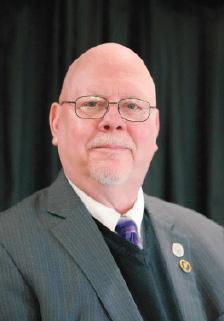
We believe that the Founding Fathers, when they wrote the Constitution, intended for us to be able to be self-governing, and part of the essential human rights is the ability for someone to determine their destiny without government constantly interfering in every piece of that.”
-
DONALD RAINWATER (L), governor candidate
yourself. You don’t expect everybody else to protect you,” Rainwater said. “If you want to take the vaccine, you take the vaccine. If you don’t, you don’t. Because I’ve never heard anybody explain to me how, if I’m not vaccinated and you are, how me not being vaccinated hurts you. It can hurt me but not you.”
According to the United States Department of Health and Human Services, vaccinations create “community immunity,” meaning when the majority of a community gets vaccinated, “the germs can’t travel as easily from person to person — and the entire community is less likely to get the disease.”
Rainwater says this idea of personal choice and freedom of choice comes from a “non-aggression principle,” which teaches that one can do whatever they want as long as it doesn’t infringe on the rights of someone else. This principle also drives Rainwater’s feelings on marijuana legalization in the state.
“There are also people who self-medicate with alcohol, other drugs, who want to be able to legally purchase and use cannabis,” Rainwater said. “If we have legal tobacco, legal alcohol, why don’t we have legal cannabis? There is no reason logically that I can see other than somebody else would have a profit margin hit if cannabis were legal.”
In terms of agriculture, one thing that Hudson hopes to contribute to if she was lieutenant governor is to “roll back the overregulated industry.” Hudson references farmers who are struggling to make ends meet due to “all the rules and regulations.”
“I had a farmer say that he’s getting into solar panels, and which is only a small percentage of farmland, but it helps produce alternative electricity and can be a boost for some communities,” Hudson said. “That’s one of the things that some farmers are looking at leasing their land as solar in the industry there, just so they can have some money to pay their bills”
Mike Braun and Micah Beckwith
Mike Braun, the Republican candidate for governor, calls himself a “conservative outsider,” according to his website.
Braun has been a U.S. Senator since 2018 and serves as the lead Republican on the Aging Committee. He also serves on the Agriculture Committee, Budget Committee, and the Health, Education, Labor and Pensions Committee (HELP), according to his senate website.
Running with Braun is Noblesville pastor Micah Beckwith, who was narrowly nominated in a vote of 891 to 828 over Trump-endorsed and Braun’s first pick, Representative Julie McGuire, according to the Indiana Capital Chronicle.
For Beckwith, the key points of his campaign include creating a “more conservative state,” embracing a limited government and providing solutions.
“I believe Ronald Reagan when he said ‘The nine most scary words in the English language are, ‘I’m with the government, and I’m here to help,’” Beckwith said. “I really think sometimes the government trips over itself. And if we just kind of get government out of the way and let people be able to do what [they want] with their God given gifts … that is what government really needs to be focused on saying.”
Regarding reproductive rights, Beckwith asserts he believes that the term should be “abortion issues,” citing his long standing beliefs in medical freedom, such as a right to not be vaccinated but believes “abortion is killing a human life.”
“I think that where the left is very inconsistent on this issue is when does life begin? You can talk to a Democrat, somebody on the left, and they can’t give you a specific time,” Beckwith said. “Some say three weeks, some say three months, some say third trimester; some say after the baby’s born, and some say not even after the baby’s born.”

I believe Ronald Reagan when he said when he said ‘The nine most scary words in the English language are, I’m with the government, and I’m here to help.’”
- MICAH BECKWITH (R), Lieutenant governor candidate
On the conversation of healthcare and reproductive rights, Rainwater said he is a “pro-life libertarian,” but ultimately, believes that one’s healthcare choice is theirs and not the government’s.
“During the pandemic, if you want to wear a mask, you wear a mask. If you don’t want to wear a mask, you don’t wear a mask. You protect
Outside of his pastoral and small business entrepreneurial work, Beckwith’s political career includes about five years doing policy work with the Indiana Family Institute and was prominent in a Hamilton County public library effort to relocate allegedly inappropriate books, according to the Indiana Capital Chronicle.
“I got kicked out of the Hamilton County Republican Party in 2021 because I was very critical of the republican leadership. I’m not just a ‘Republicans are best because that’s just what it is,’” Beckwith said. “If you are not fully true to republican principles, I’m going to call you on it.”
4See GOVERNOR, 14
• Serve as the chief executive officer of the state and oversees the executive branch
• Report on the condition of the state every January
• Recommend legislation
• Review bills to either veto or sign into law
• Serve as commander-in-chief of the state’s armed forces.
• Grant reprieves, commutations and pardons
• Preside over the senate
• Cast deciding votes in the event of a tie
• Assume the role of governor if the sitting governor becomes unable to fulfill the duties of office
• Oversee the following state agencies:
• Indiana State Department of Agriculture
• Indiana Housing & Community Development
• Indiana Office of Tourism Development
• Indiana Office of Community & Rural Affairs
• Chair the following:
• Indiana Mental Health Roundtable
• The Intellectual and Development Disabilities Task Force
• The Civics Education Commission
Fewer than a quarter of those registered to vote in Delaware County voted in the most recent primary.
Maci Hoskins, Trinity Rea Ball Bearings Co-Associate Editors
In the most recent Delaware county primary, which took place May 7, 74,508 people were registered to vote.
Fewer than a quarter of those registered voters actually cast a vote.
This 18.3 percent voter turnout, or percentage of eligible voters who vote in an election, is not abnormal for Muncie and the surrounding Delaware County area. In the 2020 presidential election, Delaware County had a voter turnout of 58 percent, meaning that just over half of registered voters cast their vote.
This percentage is tied for the lowest voter turnout rate out of all 92 counties in Indiana.
For the past 20 years, Indiana’s voter turnout has been lower than the U.S. average, according to the 2023 Indiana Civic Health Engagement report. The report details that from 2016 to 2020, Indiana’s average turnout “increased by 5.7 percent, however, nationally voter turnout soared.”
Indiana State Representative Sue Errington (D-District 34) said Delaware County’s consistent downfall of voter turnout was due to a multitude of reasons, one of which is Indiana’s low civic engagement.
“The entire state is also low on voter registration,” Errington said. “... If you don’t get registered, then you’re not going to have voter turnout.”
Errington has been in office since 2012 and experienced a general decrease, then increase, of voter turnout in the 2016 and 2020 presidential elections.
Errington said she believes this upcoming presidential election will significantly affect young people, particularly college students. She claimed there’s “a lot at stake” for young individuals.
“I don’t think people realize how much local government affects their lives,” Errington said.
Former mayoral candidate and Development Director for Shafer Leadership Academy Jeff Robinson agreed that educating Muncie residents and youth voters about the importance of local elections is crucial.
According to the National Civic League, turnout for local elections is “historically both low and less representative of community demographics.” Across the U.S., only 15 to 27 percent of eligible voters cast a ballot in their local election.
During his campaign, Robinson experienced the lack of local voter turnout firsthand, losing the mayoral race by fewer than 500 votes.
“I knocked on about 17,000 doors in Muncie city limits. Most people don’t know what’s going on … people didn’t know what was happening on major projects in the city,” Robinson said. “I don’t think that’s just a Muncie problem, but people are just

I think those things would certainly help, but I mean, how do you fix apathy? … You know, I[‘ve] had people say, ‘Oh, my vote doesn’t matter.’ Well, it does … It’s tough to fix that.”
-
JEFF ROBINSON, Former mayoral candidate and development director for Shafer Leadership Academy
sick of politics, and people are sick of voting and sick of elections.”
Robinson said a huge contributor to low voter turnout is the youth population and their thoughts and opinions.
According to KFF, which was formerly known as The Kaiser Family Foundation, only 39 percent of Indiana’s registered voters aged 18 to 24 voted in the 2020 presidential election.
According to Ball State University Center for Economic and Civic Learning’s 2024 report ‘Ball State Voting Trends,’ there has been “a significant decline in student voting rates from 2018 to 2022, with an 11 percent drop overall.”
Robinson said this has to change. While he had ideas for on-campus voting polls and registration booths and ran on such during his campaign, he said “people on the opposite side of the aisle” blocked the initiatives.
Robinson said ensuring Ball State students can vote on campus would benefit not only Muncie community members but student’s quality of life on and off campus as well.
“Ball State students could have a tremendous amount of power in this community if you know you don’t have to go back home to vote,” Robinson said. “You can register right here, and you can choose to vote right here … Ball State students can help with [voting to fix] the roads [and] sidewalks.”
Republican candidate for the Indiana House of Representatives District 34 Susan Dillon said Ball State voters have been a focus for her party.
“I know that our county Republican Party is attempting to look into that and see what kind of support is needed in the Ball State area to help support, specifically the Republican voters that are on campus,” she said.
Dillon acknowledged while students can play
a big role, another key part of increasing voter turnout is ensuring voters know their candidates.
“If a candidate has not earned my vote, and I don’t know who they are, what they stand for, what their plan is for the position that they’re going into, quite frankly, I don’t want to vote for them. I can appreciate people not wanting to show up and vote when they don’t even know who the candidates are,” she said.
According to the working paper Measuring Voters’ Knowledge of Political News, published by Andrea Prat at Columbia University, half of U.S. residents, when confronted with a real and fake news story, were unable to identify the true story.
Dillion said enacting her parties suggested measures and encouraging voter education will not immediately fix low voter turnout but could begin to turn it around for the county and the state.
Errington agreed and believes the importance of educating voters on the significance of their vote and on who their candidates are is key.
Robinson said that while all of these ideas can help, low voter turnout might be more difficult to permanently fix.
“I think those things would certainly help, but I mean, how do you fix apathy? … You know, I[‘ve] had people say, ‘Oh, my vote doesn’t matter.’ Well, it does … It’s tough to fix that,” Robinson said.
Contact Maci Hoskins via email at maci. hoskins@bsu.edu or Trinity Rea via email at trinity.rea@bsu.edu.


challenging a flag while facing Marion Oct. 11 at Muncie Central High School. Over the past three seasons, Padgett has been tasked with bringing Bearcat football back to the success it once had in the early 2000s.
DN
Sports Editor
The revitalization of Muncie Central’s football program began in the 2022 season with the hiring of now-head coach Kyle Padgett. Over the past three seasons, Padgett has been tasked with bringing Bearcat football back to what it once was in the early 2000s — a school that won four sectional titles in five years.
He saw the Muncie Central job as a golden opportunity to put his dreams into action.
“I always want to go battle for the downtrodden or the little guy,” Padgett said. “In the football community, Muncie Central is kind of considered a graveyard or a dead-end job, and I like a good challenge.”
It certainly was a challenge as Muncie Central was coming off the heels of three straight seasons of two wins or fewer.
A long-term plan was needed to turn a program that hadn’t had a winning season in six years around. The details of that plan contained ideas that had nothing to do with the football field but instead a culture change.
“[Padgett’s] vision of what Muncie Central football would look like under his guidance was very appealing,” Muncie Central athletic director Jeff Holloway said via email. “He spoke a lot about culture and standards, and you can see the growth as he implements that vision on a daily basis.”
A part of the vision that was cast on Holloway during the initial hiring process was to change the culture of the football program and the school.
“In our community, there’s already a commitment
issue,” Padgett said. “If you look at our school attendance and nature, that’s something we’ve got to overcome. To come in and think that you can automatically get commitment and consistency in athletics is naive.”
The priority of being more than just athletes but student-athletes has rang true during Padgett’s tenure. Holloway said success in the classroom has drastically improved under Padgett’s supervision.
“I’ve seen the most growth in the classroom,” Holloway said. “... The number of absences and tardies to class [has] become almost nonexistent under the direction of coach Padgett. He preaches the importance of ‘how you do anything is how you do everything,’ and our kids are starting to mimic that.”
See GROUND, 14
The Cardinals jumped five spots in the final round at the Everett Buick GMC Classic. Junior Carter Smith shot a 3-under 69 in the final round, securing himself a second place finish, just one stroke behind first. Ball State has one competition left in its fall schedule, heading to the White Sands Bahamas Invitational starting Oct. 25.
Ball State football senior Malcom Gillie was named to the watchlist for the Jet Award, an award for kickoff returners. The award is named after Johnny “The Jet” Rodgers, a former Heisman Trophy winner and College Football Hall of Famer. Gillie is second in the country for kick returns and has a 33.5 yard average.
Ball State heads on the road for the next four games of Mid-American Conference (MAC) play. The trip starts this weekend as the red and white face Ohio University Oct. 18 at 6 p.m. The following day, Oct. 19, Ball State will head to Kent State for a match starting at 4 p.m. The Cardinals enter the trip with a 10-8 overall record and a 3-4 MAC streak.



It all didn’t process for me until a few days later. I was more excited about qualifying for that tournament that I honestly wish I [posted the commitment] on a different day so I could have gotten the full experience.”
- LANDON “HAPPY” GILMORE, Ball State men’s golfer
mind on a commitment to the Cardinals around winter of 2022, although he took his time in making an official decision.
Gilmore said he let Fleck know a day before the 2023 IHSAA State Championship, and the only other people who knew were the few players he had spoken to outside of his campus visit.
Fast forward to June 23, 2023, Gilmore officially posted his commitment to Ball State on X the morning before the US Junior Open Qualifier at the Delaware Country Club. As he puts it, he posted the commitment on X not long before his tee time.
Gilmore put his phone back in the bag and out of his mind, proceeding to qualify for the U.S. Junior Open by shooting a score of 66.
“I was not on my phone for almost half of the day, and I looked at my phone to see how it did,” Gilmore said. “It was at 450,000 views.”
Corbin Hubert Reporter
It all started with a long drive.
A long drive competition, that is, to see who could drive a golf ball down the fairway the longest at the 2011 Pepsi Little People’s Golf Tournament. A competition that has been won by now Ball State freshman golfer Landon “Happy” Gilmore.
Gilmore was bestowed the nickname “Happy” at age six by an onlooker for winning said competition — and it happened to stick.
At the time, Gilmore was aware of the film “Happy Gilmore,” but it took some time for him to appreciate his new nickname.
“I would say I was around 13 when I finally got the connections and realized how popular the movie was,” Gilmore said.
Gilmore said the onlooker giving him his famous nickname is one of his earliest memories of competitive golf, and his ability to play golf competitively as a youth made him realize how much he loved the game.
Gilmore made waves in the junior golf circuit, as he qualified for the 2023 United States Junior Amateur Championship and finished as the runner-up at the 2023 Indiana Golf Hoosier Junior Championship. He capped off 2023 with a
fourth-place finish in the Golfweek International Junior Invitational.
A successful time on the golf course on the junior circuits did not translate to the enjoyment of time spent off the course.
“There is so much dead time when our rounds will end. Some days it is five o’clock, and you don’t really have enough time to go do something,” Gilmore said. “You go [to the course], play your round and then sit in a hotel room for four or five hours, then you go to bed.”
The Bloomfield, Indiana, native attended Bloomington South High School and continued to make a name for himself on the golf course under head coach Dustin Carver.
During each of Gilmore’s four years with the Panthers, the team made the Indiana High School Athletic Association (IHSAA) State Finals. Every year, Bloomington South placed in the top 10. Carver said he remembered the first time he saw Gilmore swing a club and knew he was going to be a good addition to his team.
In Gilmore’s senior campaign, he had his own personal best finish, placing 11th out of all players.
Gilmore said he is proud of what he accomplished in high school but admitted he wished he could have won a state championship for his coach, who retired from coaching Bloomington
South at the end of last season. He is now in an administrative role with the school.
“Me and the whole team, we had the goal of winning it,” Gilmore said. “It may have hurt us because we wanted it so bad for coach [Carver].”
Carver said he was lucky to coach Gilmore and expressed a similar sentiment toward all of his players. He said he was very fortunate to give back and teach for something that is a big part of his life in golf.
“It’s all about being able to wrap your arm around them after the rounds are played and having these conversations about life outside of golf,” Carver said.
Ball State men’s golf head coach Mike Fleck reached out to Gilmore in June 2022 after a thensecond-straight state championship appearance.
Gilmore said Fleck was the first one from Ball State to reach out to him via text message. And within 24 hours, Gilmore had secured his first phone call with Fleck.
That September, Gilmore made his first visit to the campus and started to feel a real connection to university life.
“[After seeing] the team, their facilities, the coach and all that stuff, I was pretty much locked in on coming here,” Gilmore said.
Gilmore said he had more or less made up his
Gilmore went and talked to a friend, then checked his phone 20 minutes later — the post had reached five million views and was retweeted by Adam Sandler, star of the 1996 film “Happy Gilmore.”
“It all didn’t process for me until a few days later,” Gilmore said. “I was more excited about qualifying for that tournament. I honestly wish I [posted the commitment] on a different day so I could have gotten the full experience.”
After posting his commitment, Gilmore played through his senior year and in various tournaments. In the aforementioned state championship meet, Gilmore was, at one point, two shots off of the lead. He shot a 70 in the first round and a 79 in the second round to get him at 149.
Now, in October 2024, Gilmore has played in numerous events for the Cardinals.
“It’s been awesome having Happy around,” Fleck said. “He’s obviously an outstanding golfer, but he’s also an outstanding young man.”
Ball State and Gilmore have one more event for the fall portion of their season: Oct. 25-27 at the White Sands Bahamas Invitational before a sabbatical from competition.
The season resumes for the Cardinals in February, as they look to defend their 2024 MidAmerican Conference Championship.
Contact Corbin Hubert via email at cchubert@ bsu.edu or on X @corbin_hubert_.



Muncie OUTreach is holding a “LGBTQ+ Spooktacular” for middle and high school students Oct. 26 from 7 to 10 p.m. Attendance to the Halloween dance is free and will take place on the third floor of Cornerstone Center for the Arts in the Majestic Room. The dance will have “great Halloween vibes,” and costumes are encouraged
The 2024 Ball State Homecoming Bed Race will be Oct. 25 at noon on Riverside Avenue. Entry fees are $25 per first team and $20 for each additional team. Each team consists of four people pushing the bed down the 100-yard course and a fifth person on the bed. The first-place team will receive a plaque, and the team with the best costume will get a trophy.
Check-in for the annual parade of Muncie pets in their Halloween costumes will be Oct. 26 at 12:30 p.m. The Costumed Creature Crawl will begin at 1 p.m. at the county building and finish at Canan Commons, where they will hold the costume contest. There will also be a free hotdog waiting for costumed pets when they arrive at Canan Commons.
Ball State’s David Owsley Museum of Art’s fall exhibit is now open.
Madelyn Bracken Reporter
From her versatile mediums and strong topics, the art of Elizabeth Catlett commands your attention. Ball State University’s David Owsley Museum of Art (DOMA) is hosting her work in its fall exhibition, “The Art of Elizabeth Catlett from the Collection of Samella Lewis.”
Having a temporary home at Ball State University, the collection of art features prolific African-American artist Elizabeth Catlett and is curated by her student and friend, Samella Lewis. Catlett’s work is a spectrum, containing a variety of different themes and styles.
“She does the whole gamut from abstract to realism,” DOMA Director Robert LaFrance said.
The exhibit focuses on topics like the strength of Black women, Afrofemcentrism, Black power and the Civil Rights Movement.
Catlett, originally from Washington, D.C., attended Howard University in 1931. After teaching art post-university, she returned to being a student. Catlett went on to the University of Iowa, becoming the first to graduate with a master of fine arts from the institution.
While her original degree was focused on printmaking, design and drawing, her masters widened her abilities to include painting and sculpture. While at the University of Iowa, Catlett studied under and was inspired by American Regionalist painter Grant Wood. It was at this time that she began working more heavily with wood and bronze sculpture, similar to pieces featured in the DOMA exhibition.
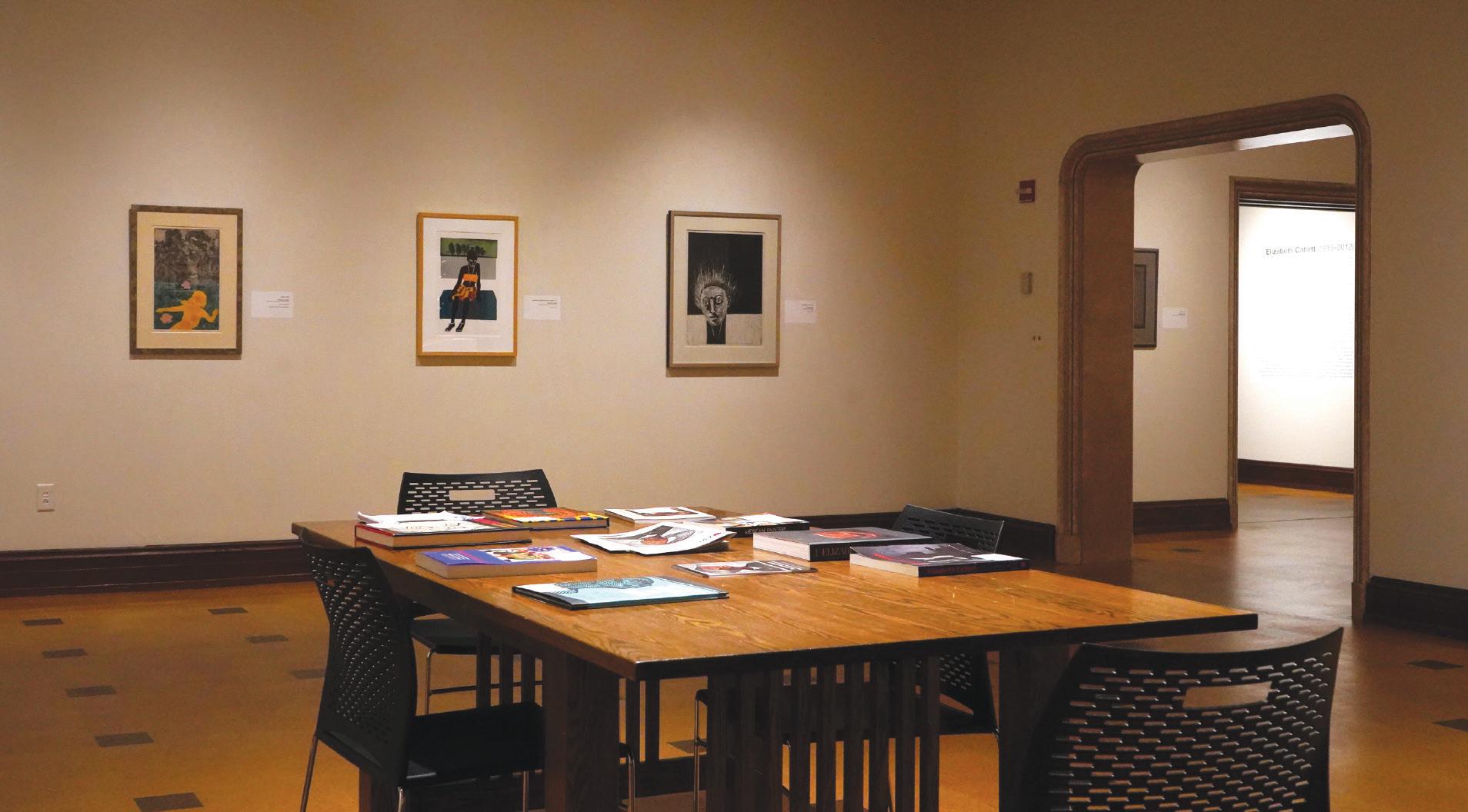
Chair of the Department of Women’s Gender and African American Studies and professor of English Sharon Jones said the work of Catlett emphasizes the depth, complexity, nuance and importance of marginalized groups.
“So much of her art resonates with her interest in a variety of topics, but one of the things I appreciate about her art is the way she often centered groups of people who had often been relegated to the sidelines,” Jones said.
The exhibit includes pieces like “The Sharecropper,” as well as many others. But Catlett’s work is not alone in this exhibit. To connect Catlett to her influences and paint a larger picture to present in the exhibit, LaFrance paired her work with those she learned from, was inspired by and also taught.
Some of which were pieces by Mexican muralists.
“The reason [Catlett] went to Mexico in the first place was to see works by the Mexican muralists,” LaFrance said. “We have a couple of really nice things, with one by Rivera and the other by Siqueiros.”
Her trip to Mexico was not intended to be long, but eventually, she moved there in 1947, marrying Mexican muralist Francisco Mora.
Muralists had a major focus on political and social ideas and shifting public views, which aligned with Catlett. Although residing in Mexico at the time, Catlett stayed aware of U.S. movements
in the 1960s and 1970s, such as the Black power movement. Her alignment eventually barred her from entering the U.S., and her citizenship was not reinstated until 2002.
Mya Whitis, museum education and collections intern and docent, explained what the exhibition means to her, as well as the feelings and conversations she believes it can start.
The
“Especially with the election coming up, having a show that stirs that type of feeling — and most importantly, conversations among students — it’s just absolutely necessary,” Whitis said.
Jones highlighted that the exhibition and it provoking topics can give viewers a chance to confront history in a different way than they may be able to typically.
fact that the show is so consistent in its message that you can go to the show and all of a sudden have a deeper understanding of past generations and how this affects them and you. That’s what made me like this was the time to have this show.”
- MYA WHITIS, Museum education and collections intern and docent
“To have these prints that are very dignified and tell our history and our story, but also do it in a way that’s not just, ‘Hey, we’re angry,’ but here’s why we’re angry,” Whitis said. “I think that is priceless.”
Whitis believes that the exhibition can do more than just tell a story and spark real and important conversations about the topics presented at a crucial time.
“I think that confronting it through art can be very moving,” Jones said. “There’s a lot of ways to confront history, and I think that works of art will often make people unpack, explore, examine and discuss what it means to them.”
DOMA adds various interactive activities to its exhibitions to increase learning and engagement. Catlett’s exhibition is no different. At the exit of the exhibit, visitors will find a room with walls full of
various questions, encouraging you to take a sticky note and write your answer.
The questions revolve around the idea of radical empathy, coined by author Terri Givens in 2021. Givens defines her term in the synopsis of her book “Radical Empathy.”
“Radical empathy [means] moving beyond an understanding of others’ lives and pain to understand the origins of our biases, including internalized oppression,” Givens said.
Whitis honed in on a specific question which asked, “Who is a woman you look up to?”
“I saw three post-its that said ‘my mom,’ and I thought that was really important,” Whitis said. “The fact that the show is so consistent in its message that you can go to the show and all of a sudden have a deeper understanding of past generations and how this affects them and you.”
The purpose of these questions is — much like the pieces in the exhibit — to encourage conversation and thought around the topics presented.
“I hope people come and see the show, look at the art, begin to understand it, and practice a little radical empathy before and after they leave,” LaFrance said.
The exhibition is open at DOMA during the museum’s regular hours, running until Dec. 20. It will be closed from Nov. 27 to Dec. 2 for Thanksgiving break.
Contact Madelyn Bracken via email at madelyn. bracken@bsu.edu.
Ball Bearings is a student-run magazine that publishes in-depth stories in print and online. The publication explores issues that have a regional and national impact through the lens of Ball State University students. With its emphasis on “why,” Ball Bearings provides readers with thought-provoking feature stories, columns and commentary, essays and criticism, and Q&As that focus on what it means to live now.




Ball Bearings is looking for writers, photographers and designers to join our team. Contact us at ballbearingsmag.com.







































































movement has steadily moved into the political arena.
Columnist, “Inner Thoughts”
Jacob Rodgers is a third-year media major and writes “Inner Thoughts” for the Daily News. His views do not necessarily reflect those of the newspaper.
Frontline, “If you ask 99.9 percent of parents who have children with autism if we’d rather have the measles versus autism, we’d sign up for the measles.”
which has been dubbed the “vaccine choice movement.”
The COVID-19 pandemic shut down the country in 2020, yet we eventually managed to get a vaccine for the virus which became mandated in the same ways as other vaccines.

Suggesting that vaccines cause autism or that you would rather your child have measles over autism is inherently ableist. McCarthy basically implied autism is a scary and dangerous disease that should be a bigger concern than polio or the flu.

I was 2 years old when I was diagnosed with autism.
I was a toddler during the early stage of the antivaccine movement in the early 2000s. Autism was not well-known, and there were already feelings of concern and even fear towards the disorder.
Those feelings are still alive in 2024.
The anti-vaccine movement started to garner more attention around the time I was in kindergarten, creating a large level of uncertainty about autism. It got to a point where my classmates’ parents suggested I had a disease. Luckily for me, that rhetoric was short-lived, but now it is back and stronger than ever before.
A survey of 1,500 U.S. adults from the Annenberg Public Policy Center at the University of Pennsylvania found that confidence in vaccines has dropped from 77 percent in 2021 to 71 percent in 2023. The survey also showed an increase in those who believe that the MMR vaccine may cause autism from 9 percent in 2021 to 12 percent in 2023.
While these may be small increases in skepticism, keep in mind that this only occurred in just two years. With the aftermath of the COVID-19 pandemic, this trend will probably grow even more.
The rise and phenomenon of anti-vax rhetoric first occurred in 1998. British doctor Andrew Wakefield and 12 of his colleagues published a case series in The Lancet that suggested the Measles Mumps Rubella (MMR) vaccine may lead to behavioral regression and pervasive developmental disorders in children. This resulted in many in the medical world debunking this study, and it cost Wakefield his license to practice medicine due to the data being fraudulent.
Regardless of this, some members of the general public became skeptical about vaccines, and the publicity behind the study resulted in a decline in MMR vaccinations. This ultimately led to celebrities like Jenny McCarthy’s gaining influence as an anti-vaccine activist. McCarthy, a former Playboy model turned actress, claims that her son’s autism was caused by the MMR vaccine and that putting him on a healthy diet helped “cure” his autism. Her celebrity influence boosted the anti-vaccine movement and her charisma managed to make her come off as reasonable and articulate McCarthy openly stated during an interview with PBS’



As someone with autism who has gotten all of my vaccines, my autism is not a deadly disease.
This has become a common argument for antivaccine activists for many years and has also led to a rise and interest in embracing “natural” and pseudoenvironmentalism. Wellness influencers have begun to promote natural immunity theories, recommending “organic” alternatives to medicine.
Rhetoric from conservative-leaning outlets and politicians caused an immediate distrust in the vaccine. It wasn’t just right-wing outlets, as I saw this become an online trend due to popular podcast hosts suggesting that we “just needed more research” on the vaccine before taking it — an argument that has been used to justify questioning the MMR vaccine’s efficiency for years.
According to a Pew Research Poll, this rhetoric has significantly impacted the public’s perception of the COVID vaccine’s safety. The poll showed that 69 percent of U.S. adults were fully vaccinated from COVID by August of 2021. In 2024, only 28 percent of Americans were fully vaccinated from COVID.
Arguably, the most prominent anti-vaxxer is currently being given a platform by former President Donald Trump: Robert F. Kennedy Jr. Kennedy is an environmental lawyer who ran for the 2024 Democratic nomination for President of the United States.


The anti-vaccine movement is stronger than ever, and what was once considered extreme is now considered mainstream.”
An article written by Dr. Traci Volyes for Indiana University of Pennsylvania states, “Because concerns over vaccines are now so closely linked to concerns over ‘being green,’ autism likewise comes to be imagined as an environmental problem: vaccines are seen as pollutants in a very literal sense, and children with autism are seen by opponents of childhood vaccines as victims of mercury pollution.”



Kennedy founded Children’s Health Defense in 2007 and utilized it to cause anti-vaccine skepticism abroad.
In December 2019, the government of Samoa was completely shut down for two days as the country was facing a severe measles outbreak. An article by Ars Technica detailed how RFK Jr. and Children’s Health Defense traveled to Samoa and attempted to persuade the Prime Minister of Samoa at the time to question the MMR vaccine.
This came after it was reported two young Samoans died in 2018 due to complications of the vaccine. In reality, the nurses who administered the vaccine to both men mixed a lethal dose of muscle relaxant in each syringe and tried to cover it up.

None of these facts mattered to RFK Jr. or his organization, and Samoa’s vaccine rate declined to just 31 percent. Over 3,700 people got sick from measles and more than 50 young children died in the country.




This area of anti-vaccine skepticism has drastically changed the anti-vax rhetoric. In the past 5-10 years, anti-vaccine viewpoints have grown more politicized than ever. There has been a rise in demands for personal freedom against vaccines even if it risks public health,

The anti-vaccine movement is stronger than ever, and what was once considered extreme is now considered mainstream. With Kennedy potentially becoming the next Secretary of Health and Human Services, I cannot help but encourage the general public to educate themselves on the importance of vaccines.

Contact Jacob Rodgers via email at jacob.rodgers@ bsu.edu.






Continued from Page 05
Beckwith’s claim that laws allow for the killing of a baby after birth likely refers to the 2022 myth that a California bill would allow mothers to kill their babies up to seven days after birth, which the Associated Press (AP) reported to be untrue.
Braun said that he would consider abortion for instances like rape or incest, hoping that if a baby was conceived by rape and was then aborted, the rapist would be charged for rape and homicide, detering other rapists from commiting rape.
“If there’s an abortion due to that rape, then that person who committed the rape should be charged with murder as well because you caused an infant life to lose its life because of what your actions did,” Beckwith said. “… If you’re going to abort the child because of what the man did in this evil act, punish the man for both the rape and the murder, and I think that then government has done its job.”
Beckwith also shares that the idea of “pro-life” is a core value of Indiana.
“Indiana has always been a very pro-life and pro-liberty state. We were always a free state. We never had slaves,” Beckwith said. “We stood up to the South when the South was saying they wanted slaves, and we said, ‘No, we’re not going to do that because we believe God gives us the right to life and liberty and the pursuit of happiness.’”
The Indiana State Historical Bureau reported that the 1800 federal census recorded “135 slaves and 163 free blacks in the territory. The 1810 census recorded 237 slaves and 393 free blacks.”
Beckwith said he embraces and believes in conservation to help ensure farmers’ security.
“Conservatives conserve because we know we have to protect what God has gifted us,” Beckwith said. “Farmers have a duty to steward what they have been given.”
Beckwith points to things like cover crops, agrivoltaics and protecting small, family-owned farms as ways he plans to continue to support agriculture in the state.
Beckwith said his campaign with Braun is embracing a “parent-first” education approach, which he said counters the “teachers and teachers-union” approach that he believes Democrats are taking.
“I think Republicans will say, ‘Hey, parents have to be the driving force of education,’”
Beckwith said. “They are the ones that are given the authority by God to raise up children. It’s not the state’s job, it’s not the teacher’s job — it’s their job to come alongside parents and help.”
Beckwith and Braun also have a campaign plan to lower property taxes. According to the Braun For Indiana website, their campaign plans to “Overhaul the homestead deduction to allow every homeowner with an assessed value over $125,000 to deduct 60 percent of their home’s assessed value from their tax bill. Homeowners with assessed value below $125,000 would be allowed to take the standard deduction of $48,000, in addition to a 60% supplemental deduction.”
Contact Olivia Ground via email at olivia. ground@bsu.edu.
NewsLink Indiana Members Abby Urban, Gavin Coe, Brooke Folrad and Sophie Schick contributed to this article.

Continued from Page 07
After year one under Padgett, he said the vibe around the Muncie Central football team was much different from the athletic director down to the players. But that was just step one in the rebuilding process.
Next on Padgett’s docket were the lower-level programs at Northside and Southside Middle School. The last time both middle schools had a fully functioning football program was in 2018.
Rejuvenating a program that had been dormant for five years was no small task. Padgett’s priority was to gather a coaching staff where everyone was on the same page. An essential part of his plan was to make sure everything was academically and athletically consistent from the top level to the bottom.
“We did some revamping with our coaching staff there, and spent a lot of time together with our middle school staff and got them completely on board,” Padgett said. “As far as running our offense and our defense, they did a lot of clinicing with us and spent a lot of time in our practices. We’re seeing that success at the middle school level.”
A part of that revamped coaching staff for the Muncie middle school team is offensive and defensive line coach Joseph Boggs. He said the opportunity to be a part of the development of the Muncie football program means a lot to him.
“[I told myself], if you’re wanting to be a good coach, this is where you’re going to learn it,” Boggs said. “I felt that it would be beneficial for me and the community.”
Boggs was brought on staff in large part because of his playing days at Ball State as an offensive tackle. Padgett wanted to address technique issues across the board and hired Boggs to negate those technical problems on the offensive and defensive line.
“My goal is to give [Padgett] kids who know how to get in a three-point stance, fire off, use their hands and understand the scheme of Muncie football,” Boggs said.
Building those programs started in the weight room. Padgett said there has been a concerted effort to get at least 90 percent of Muncie Central athletes enrolled in a weightlifting class. That effort has paid off thus far with a growth of 100 more athletes in those classes growing from 197 to now 300 enrolled.
This heavy emphasis on the weight room is something Padgett wants to ensure is consistent at the middle school level to allow for cohesion throughout the entire Muncie football program.
“They’ve now created a strength and conditioning program at both middle schools, and that sets a foundation for our kids, and they’ll be ahead of the game once they get to high school,” Padgett said.
“That’s where we decided to put all our poker chips
Junior quarterback Alakai Wallace throws the ball against Marion Oct. 11 at Muncie Central High School. A long-term plan was needed at Muncie Central to turn a program that hadn’t had a winning season in six years around. ANDREW BERGER, DN
down, and we’ve seen the benefits of that.” Boggs, who’s a part of that middle school weightlifting program, has been able to see the dividends that have been paid through the effort put into that aspect of player development.
A weightlifting program called “The Breakfast Club” is an early morning session implemented for all middle and high school athletes to come to the weight room and lift.
“Everybody wants to go to the first one because that’s when the most people are going to be there and when it’s the most fun,” Boggs said. “But when you get two months into the summer they’re not wanting to wake up at 7 a.m. to go to Breakfast Club anymore.”
This program has been a critical part of the development of the middle school athletes getting to train alongside the high schoolers and also receive the same coaching as their older counterparts.
“Our coaches are consistent, and we tell them, ‘We’re going to be there, so you should be there, and if you’re not there, we’re going to ask you why, and you’re going to get calls why. If you were busy, well, I need you not to be busy next time,’” Boggs said. “It’s about consistently digging them and trying to give them an idea that this is serious. If you want to play for us, if you want to be good, you need to be here.”
A devotion to the weight room has led to the growth and size of the program, but many of these steps would not be possible without the full support of those above Padgett. He said the most important part of this process is Holloway’s unwavering support.
“The thing that gives me confidence in growing the program is the way coach Padgett pays attention to the details,” Holloway said. “His commitment to building the program from the bottom up with the youth is a testament to his passion for building a complete program.”
Padgett’s commitment to the youth has been what he has strived for throughout this process. Bringing in more and more disciplined players when they get to the high school level has been the goal from the beginning.
This year, and in the coming offseason, the youth league is where Padgett is focused most.
“We’ve been going around with our hair on fire shifting our focus to the youth league level,” he said.
The focus on the youth level is a part of the development that is the key ingredient in Padgett’s plan to rebuild Muncie football. But in his mind, it’s not all about football. It is developing young men to become successful when they leave his care which determines whether the plan is a success.
“You won’t know how good of a job you’ve done until about 5, 10, 15 years after the kids are gone,” Padgett said. “That’s when you’re gonna know if they’re a good husband, a good father, a good worker if they’re contributing to society. That’s when you know that you’ve done it the right way.”
Contact David Moore via email at david. moore@bsu.edu or on X @gingninj63.
Enter The Ball State Daily Homecoming Contest for the chance to WIN!


• Follow @ballstatedaily socials (Instagram, Facebook, and X)
























• DM your BSU email to @ballstatedaily (Instagram, Facebook, and X)












